|
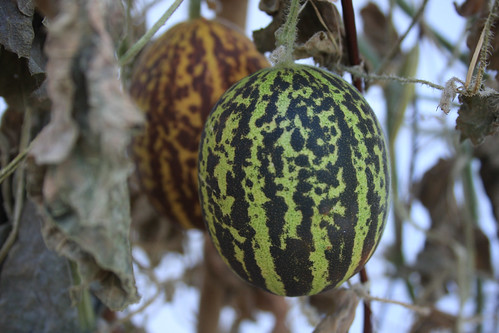
Heirloom melon, ripening on the vine in summer.
(*photo credit)
March 1, 2014 National Nutritional Month
March is a month of many topics but one is of great interest to the average citizen, National Nutrition Month. The United States is the world's largest food producer, a major exporter of rice, soybeans, corn, wheat, beef, and dairy products. Still, the nutrition is not perfect either here at home or abroad. Americans may not have bloated bellies, but malnourishment occurs in many forms.
Individual choices. Many of us stand before a massive smorgasbord; others of reduced food stamp subsidies choose what is filling rather than what is more nutritious. Too many of the less disciplined will choose the cheaper, sweeter, and more fatty and salty foods. When making choices, a little of most things is okay, but I once observed with horror a middle-aged man at a restaurant have nothing but a plate full of fried bacon -- his choice at a "salad and food bar." Focusing on single items increases restaurant prices; it's poor nutrition by undisciplined choosers. No wonder our blessed country has malnutrition.
Educational programs. Grade, high school, and college cafeterias seem loaded with overwhelming choices of what to eat. However, the managers are beginning to wise up. Portions can be smaller to avoid food wastes; reducing the choices of fatty, sugary and salty foods is helpful for others. Fast food places are disadvantageous, for some are tempted to "pig out" or overeat certain items. Governments at the local level can educate by controlling trans- and saturated fat products, soft drinks, and listing of calories of fast food items. Likewise, good nutritional training in schools should include nutritious cafeteria selections, teaching about the nutritional value of five vegetable/fruit servings per day, and preference for whole grains.
Food stamps with restrictions. A battle over amounts and extent of food stamps has been waged seriously with each new Federal farm bill. No doubt some really depend on food stamps; others abuse the practice by purchasing soft drinks (in some states). A simple solution is to restrict materials obtained by the stamps, just as today tobacco products are excluded. Some regard this as an improper restriction on freedom, but public money can be regulated for the good of all -- tax payers and recipients. Actually, staples at lower prices may be a wiser procedure.
Gardening for all. Nothing would improve national nutrition more than expanded gardening programs, which include furnishing garden space, subsidizing seeds and basic tools, giving gardening instructions for beginners, and celebrating the harvest with festivals. Second World War "Victory Gardens" are a good template for battling domestic malnutrition. Unused urban space abounds and making space available requires creative distributive programs.
Prayer: Give us, Lord, a sense of good nutrition so we can be more fitting instruments in spreading your word.
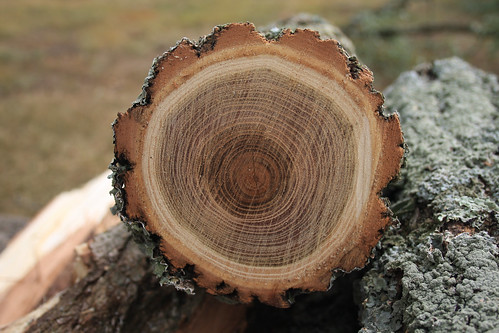
A lifetime counted in the rings of a tree.
(*photo credit)
March 2, 2014 Do Not Be Anxious about Tomorrow
This is why I am telling you not to worry about your life and what you are to eat, nor your body and how you are to clothe it. Surely life means more than food and the body more than clothing!
(Matthew 6: 25)
We will soon be moving into Lent and on this Eighth Sunday in Ordinary Time we reflect on late winter tensions and stresses as we prepare for the coming of spring. Some have mental conditions that need separate attention, but virtually all of us are tempted by a host of minor worries and frustrations. Jesus encourages us to learn from the natural world: birds and flowers are creature- teachers of the first order. God will provide for all of us, humans and all living things. Nonetheless, we spend time considering upcoming events, travel time, human reactions, etc. Anxieties loom larger than life and in passing they seem so superficial. Jesus says: Don't worry! We are consoled when the ill or those struggling expound a worry-free philosophy of life.
A series of helpful, caring publications is published by Abbey Press, St. Meinrad, IN 47577; one is entitled Overcoming Everyday Anxiety. Attention is given to ordinary worries, pounding heart, and overkill, which the flyer says, can be managed like all health problems. Constant and excessive worry is more than merely distracting; it can result in a mental condition that reduces quality of life and makes things miserable for all. Experts tell us to combat worry by learning to relax -- relieve tension through exercises, meditation, and positive self-expression. Don't let worries control life; don't play the "what if..." game called catastrophizing -- even if climate change haunts some of us.
When my imagination runs amuck with some possible disaster, I think a meteor is coming this way and I can't do a blessed thing about it. Live and do the best we can, and so why worry about anything else? Larger than normal anxieties may result through allowing things to fester; a good conversation with a friend may help. Caregivers tell us to anticipate and prepare for eventualities. When I ran conferences earlier in life, my anxiety level escalated as the event approached; while good preparation helped, still the tensions mounted as the event came near. I came to say, "Expect the unexpected and ride with the tide."
While we all have minor worries, some folks suffer from major panic attacks -- dizziness, faintness and sweating. They have irrational phobias against snakes, flying, driving, etc.; they have obsessive-compulsive disorders such as checking to see whether the stove is turned on or constantly washing one's hands; and thousands of veterans suffer from post-traumatic stress disorder. We need to help ourselves to relief and help others as well. See Anxiety & Depression Association of America, 8701 Georgia Ave., #412 Silver Springs MD, 20910. TERRAP Programs, P.O. Box 19, Hershey, PA 17033.
Prayer: Lord, give us the confidence to know that you are at our side and will help when things get rough.
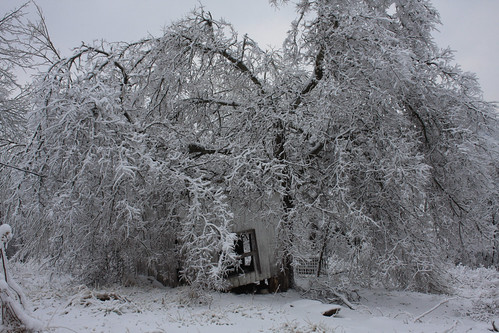
Kentucky ice storm, 2009.
(*photo credit)
March 3, 2014 Living Better with Natural Disasters
March can be the season of twisters that can ravage much of the United States; uninvited floods can occur with suddenness; earthquakes are to be expected; hurricanes may strike again along coast lines where residents are awakening to mounting flood and wind insurance bills. The United Nations and other agencies have released several reports dealing with increased frequency and severity of extreme natural events, many possibly due to climate change. The "Sandy" hurricane and storm surge of a year and a half ago had sobering results for residents living at the New York and New Jersey shore lines.
Know vulnerable conditions. Urbanization leads to poorly built structures on hillsides in Brazil and flood plains in African mega-cities, with such situations inviting troubles when storms come. However, even the best of constructed houses aren't immune. Storm shelters are needed for protection on the Plains, but even the more wealthy areas pause before contemplating the added construction costs. Scientific evidence for climate change causing extreme weather is presently inconclusive -- but that is little consolation. After the Philippine Typhoon Haiyan last fall we learned that "storms of a century" might be redefined as "of a decade." We are learning lessons: don't build in vulnerable areas, but that is where the poor are more able to erect their homes; build protective shelters where possible; and (after the 2005 Katrina disaster) don't destroy protective coastal wetlands nor protective forest cover. With rising ocean levels, higher levees may prove insufficient in vulnerable areas where residents may have to be relocated. Forests absorb water from heavy rainfall and allow a slower runoff than will denude mountain sides, and it takes time for them to grow to maturity.
Respect the elements. We cannot stop tidal waves following earthquakes, evacuate paths of unpredictable hurricanes, or protect against all floods. But we can install warning systems against some events that are spotted early. Early warning systems are far less costly to construct and ought to be globally networked. Today we have radios that are activated when storms are sighted and this can save lives. Monitoring alerts hooked to radios, phones, and other communications networks can give us precious warning time.
Respond to disasters. In some ways this part of extreme disaster events are becoming better practiced. Using modern communications and transportation systems, various agencies (including the U.S. military) are able to respond with dispatch and plentiful supplies. Such response alerts both first and second level responders. Natural disasters will continue to occur, but prudence dictates that we use every means to alert, evacuate, and protect people, and to repair damage and normalize lives ASAP.
Prayer: Lord, give us the sense of vigilance to know where damage may occur, to protect our loved ones when they occur, and to respond when people are hurt by natural disasters.

Soup kitchen preparations.
(*photo by Bill McChesney, Creative Commons)
March 4, 2014 Should We "Celebrate" Mardi Gras?
When fasting at one time took on a more formal and somewhat rigid practice, Mardi Gras ("Fat Tuesday") had a significant meaning. On that day just before Ash Wednesday, homemakers rid the food pantries of animal fats prior to meatless Lent. This resulted in special fatty dishes that brought to a close the holiday festivities of the long Christmas season. When those Lenten periods of self-sacrifice lessened in formal intensity, pre-lenten celebrations continued, but with a more secular character. Even the notion of "Shrovetide," the period of confession and penance, shifted from prior to Lent to the Lenten season itself.
We now wonder whether Mardi Gras is really purely secular -- or some might say pagan. Let's not neglect the need for celebration, nor take a Puritanical approach to these pre-Lenten days. Personally, in recent years I strive to focus more on preparing for the religious aspects of the upcoming penitential season. Our world is in the midst of several crises and we need to muster our religious resources in order to keep our faith strong and our assistance going out to all victims of weather extremes and the cruel effects of warfare.
One of our New York area Jesuit novices told me a few months back that his homeland of Yap, an island in the Pacific Ocean, is being eaten up by the rising oceanic tides; he was astounded upon returning a few years after college to discover the degree of erosion. His is not the only disappearing homeland, for others in the Pacific and Indian Oceans as well as coastal areas of various continents are experiencing the same sort of erosion. Climate change is having an effect on sensitive areas of the world and this produces a current sobering effect on us all. We certainly need times to celebrate anniversaries and special events, but the pre-seasonal preparations for Lent, though celebrations, seem out of place with such serious problems as climate change effects.
Perhaps it is time that those who have worked to alert all people to climate change as the biggest threat to our environment in human history ought to lead us to refrain from pointless celebration. A more repentant mood is in order, even while we continue hopeful confidence that the problem can be successfully addressed. Certainly this year I affirm those who say tone down this rather flimsy event. There's too much escape to fiction in this world to allow us to run from issues of global importance. Also let's continue to support victims of the disasters occurring a few months ago in the Philippine islands. A more solemn way to begin the season of Lent is to choose some arena of global disaster and send money saved from reduced food purchases for their relief and welfare. Now that is celebrating life of our brothers and sisters in a balanced way.
Prayer: Lord, deepen our sense of fairness and allow us to put off Easter celebrations so we can spend more time helping others.
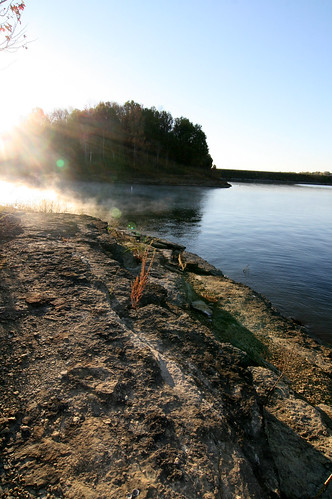
Morning at water's edge.
(*photo credit)
March 5, 2014 Remember "We Are Dust and unto Dust We Shall Return"
Today we start Lent with some very solemn words that make us return to the stark reality of our origins and the destiny of our physical bodies. From dust to dust gives us a dash of humility and a prod coming from the dust below our feet. A rich spirituality is present with those who know the shortness of life and are prepared in a reasonable manner for what is to come.
The ashes (dust) applied to foreheads of the faithful is one of the most meaningful practices of the liturgical year. Few other phrases capture the mood of a given day as the above title. It is all about our origin and destiny and what must go on in between; that time when we generate love in our hearts that needs to be increased during this season of Lent. However, there is more. These words actually show the nobility of dust, used for fashioning us by an all-powerful God who breathes life into each of us, so we can grow in the love bestowed upon us. Ashes are a reminder of one of the two major aspects of stewardship, namely, our time is limited, and we have got to make the best of it. Soon we are gone -- as the Psalms says -- "like flowers that bloom and then fade."
Our body is destined to return to dust, and so we see it both as our origins and destiny, as well as our vessel for life's journey. I am my body, but the spirit will live on. Yes, this mortal body will rise again, but that is the focus of the next season of Easter. For now, the message is more focused on the body's need for care, abnegation, and self-control during the relatively short time we are on this portion of our total journey -- for death is not the end of it all, but a new eternal beginning.
The destiny of dust is important as well. Perhaps few areas of creation are more truly lowly, for dust seems almost lifeless. If we go to the moon, we probably would kick up lifeless dust. The dry earthly soil still has that immense wealth of life in the top inch of this planet's surface. But the hidden life in dust is a foreshadowing of the evolutionary process in God's plans that brought us to where we are. The great gift of God is that we have a life in the divine image, a life that gives us immense promise and that brings the dust itself to a somewhat unexpected glory. Earth's dust is special as is the planet herself.
Lastly, the word "Remember" is part of our worship, for we are always to remember Who made us, Who came to save us, what we are made from, where we are to go, the love that is part of the gift, and our condition. When I place dust on someone's forehead I remember that a century from now we will all have moved on and that now is the golden moment to remember together our common destiny. It's an opportune instance in all its dustiness. We remember our ancestors, our suffering in life, our chosen time (of which the full span is hidden), and our future destiny, which is veiled in mystery. No wonder we find this a meaningful event.
Prayer: Lord, give us a sense of wonder and Lenten humility.
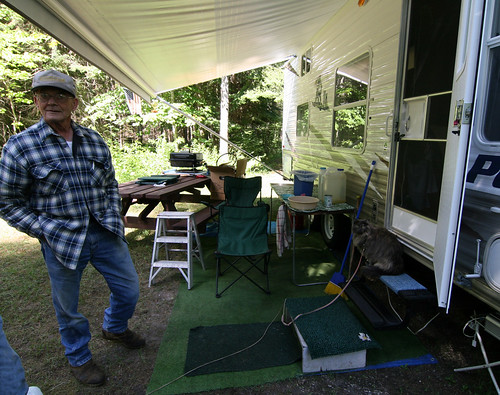
Friendly camper spends retirement as volunteer for US Forest Service. Carp River, MI.
(*photo credit)
March 6, 2014 Thoughts During American Camping Week
I have camped in every state but Hawaii, Utah, and Rhode Island and may never complete the task -- but that makes me human and not because of some sort of empty record. Camping is a good practice but good in itself and not for record keeping. We have to be psyched especially if camping in inhospitable conditions or out of necessity. Actually, camping brings many pleasant thoughts either of times past or future prospects; the former gives us the pleasure of good experiences and landscapes; the latter energies us for future vacations if time and energy permit.
Camping is grand recreation, provided the weather cooperates, the equipment is adequate and in good order, and the surroundings and partners are congenial. Actually, camping is meant for all seasons, and most places, and under a variety of conditions. If equipment is adequate one can withstand virtually any storms. I recall a severe thunder storm in southern Illinois with buckets of water pouring down; however, we had pitched a tent for proper drainage and so stayed dry throughout the ordeal. Being picky about setting a tent up develops from early camping experiences.
Choice of right place. As important as the immediate site chosen (good drainage, view, protection, and air flow) is the geographic areas where one wants to camp. Certain places are more suitable due to shorter travel distance, less congestion, less pollution, and more scenic views. A little time is well spent inspecting camping literature and talking with others who have been at certain places. Looking ahead allows campers to select proper equipment and clothing. Where possible use properly prepared public or private sites, since camping in the wilderness may damage fragile territory. If campers are careful, refrain from burning at sites or littering, even wilderness camping is worth considering.
Choose the right time. A few "polar bears" of the camping world like winter camping, when congestion is light and the sites are mostly vacant. Camping during regular vacation time can still be quite enjoyable if some effort is made to select a quiet location away from jovial crowds. Matching time and place may be challenging. Just off season may be great, for with now extended school years many vacation periods are shorter. Take extra time to enjoy the camping site and don't rush in late and out early.
Choice of campers. Though I like to camp with others, I have learned to thoroughly enjoy retreats and times of vacation when camping alone as well. Don't force people to go camping, but encourage them with easy camping first or even encourage their use of camper vehicles. Above all, attempt to make "happy campers."
Write up the experience. Most camping is fun and worth remembering as a learning process to be shared with others. Record the adventure in photos, audios, videos, or on paper.
Prayer: Lord, give us good experiences to share and enjoy.

Applesauce and fresh berry toast-tights for breakfast.
(*photo credit)
March 7, 2014 Making Breakfast the Main Meal
A Dominican priest, who was the chaplain at one of the religious communities where we performed environmental resource assessments in the Hudson Valley, attributed his very long life to living like a king at breakfast, a prince at lunch, and a pauper in the evening. Many of us testify to a bountiful breakfast, but unfortunately often stretch the royal spreads to later in the day as well. Many laborers and outdoors people of different callings swear to hearty breakfasts -- as well as some creative writers and artists who prefer to make the morning meal the main one of the day. Furthermore, breakfasts are often the least costly in restaurants.
Personal habit. At this time, I start my day very early and my first meal is often about 3:00 am. I like the meal to send me off with a special charge, and so I generally make it a generous one. This follows a tradition of having hearty breakfasts when we milked cows in early hours and then started to school or to doing other farm work. The Milford seminary that I attended was known for very large (outside Lent) breakfasts, because we rose early for prayers. One typical Midwestern Jesuit breakfast was cornbread and stew (usually a heavy beef variety with gravy) with the plate to be smothered with butter and syrup. Heavy duty!
Favorite. Since I find it challenging eating oatmeal (to control cholesterol rates) as the main ingredient even with a wide variety of fruits, berries and nuts, I try to introduce it as one, but not the main, constituent of breakfast. My favorite breakfast is a mixed type: one carrot diced into a skillet where water is brought to boil or using peanut oil; to this is added one apple, one eighth of a head of cabbage or a broccoli head, and a quarter of an onion. After steaming or frying add a half to whole cup of old-fashioned rolled oatmeal, and twice a week add an egg. Garnish with various spices and hot sauce, soy sauce, or catsup; modify ingredients at will. During the growing season vary the vegetables and herbs according to what is available. Virtually a new taste occurs for each breakfast depending on item variation.
Application. Unfortunately, growing youth have little for breakfast but Twinkies and pop to start the day. The lack of a good breakfast most likely affects youthful -- and teacher -- performance. It would pay our nation to always offer free breakfasts in schools to students (and teachers), and even during vacation periods when youth do not always have nutritious meals available. Ensure that these meals contain fruit, vegetables, and whole grains for the entire growing population. A good creative morning depends on the nourishment received before beginning sessions, and so making this the main meal makes sense. It is expected to combine big breakfasts with physical exercise sometime during the day. We all have had enough experience with people trying to perform with virtually no beginning meal; let's encourage them to change the concept of "main meal" to morning.
Prayer: Lord, help us find a balance in our food intake.

View through the pines.
(*photo credit)
March 8, 2014 Irene Dickinson, Earth Healer
As the American nuclear power system recedes into the sunset, we need to recall that forty years ago a group of heroic activists confronted an American myth that nuclear power would soon be "too cheap to meter." Such false images were challenged by alert citizens like Irene Dickinson, the foundress of National Intervenors, the first of the American anti-nuclear activist organizations. We ought to remember such 20th century heroines who are now ageless models at times of threatened climate change.
Earthhealer
Earth-loving heart, you didn't strive to gush
nor blush in the headlong rapid rush,
nor seek a polluting firm's free lunch;
nor did you steal, nor cheat, nor punch
your way to the top executive suite.
They did not crush nor reward in sullen hush;
no, no fame did greet, no glory treat,
no funded crutch, no Midas touch.
You simply accepted being ignored,
and by prayer, will, and zeal implored,
you conquered these tests, taking milder ways
and forewent comfort rests in public gaze.
Constantly, you aided all who fought
to expose desecrated water and air,
through lawsuits, reports, petitions you brought,
All that a resource-short group could share.
And still you chose the open firing line;
they bunched you with New Age, gushy hearts;
blamed you for wasting prime time,
for slowing progress, for unearthing grime,
your cross --being despised, called unrefined.
Poor Earth, poor people, you led the blind
again to fresh air, full-spectrum sunshine,
crafting a New Heaven/New Earth intertwined.
1997
Prayer: Lord, teach us to respect pioneer Earthhealers such as Irene Dickinson who were the first to join the global fray.
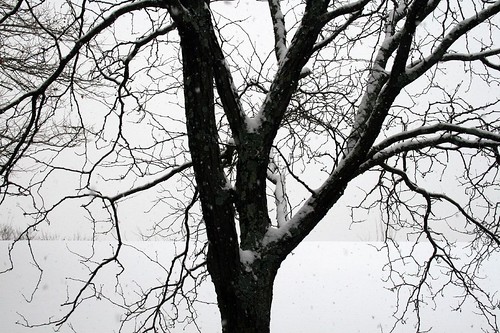
Greeting a morning in winter's white.
(*photo credit)
March 9, 2014 Confronting Temptations in an Alluring World
Then Jesus was led by the Spirit out into the wilderness to be tempted by the devil. (Matthew 4:1)
Temptations are part of the human condition, and Jesus endures all that is human except sin. From Matthew 4:1-11, Mark 1:12-13, and Luke 4:1-13 we read about Jesus' temptations -- to wealth, fame and power, by turning stone into bread, flying off the parapet of the Temple, and falling down and adoring the Evil One. Jesus successfully overcomes temptations to fame in this world by a simple life, ignominy of the cross, and obedience to the Divine Will. In Mark's short passage Jesus responds by appearing in Galilee proclaiming the good news immediately after John the Baptist's arrest; he risks public confrontation. Recall that Jesus is later tempted by Peter from going to Jerusalem.
Temptations come to us at various times in life in different ways. We may feel we have overcome certain sins of commission and then find ourselves insensitive to the needs of others and taking on a sense of self-righteousness and sins of omission -- of what our duties should be to self or others, and yet have quietly let folks slide by the wayside. We sink deeper into our comfort zones and deceive ourselves into thinking that temptation was a phase that we have now conquered -- and yet this can be dangerous.
We have confidence that God promises we will never be tempted beyond our endurance. We turn ever closer to God for help to overcome the many temptations before us, those we perceive, and those we fail to see. Thus the confessional rite of striking our breast has a deep meaning, for we are sinners. Some temptations deal with present enticements: pride in our own accomplishments; coveting wealth and resources belonging to others and even future generations; lust for power and satisfaction of bodily passions; anger over others or our own limitations, gluttony in a world of accessible foods of all sorts, envy over success of others, and a sloth which makes us reluctant to do what must be done.
Of perhaps greater importance than sins of weakness are those of omission, or removing ourselves from the duty to act in this threatened and endangered world. We are tempted to:
* deny the present condition and fail to see our current time as a creative opportunity to do good and be better. We make others the ones to blame and omit our failures in the here and now;
* excuse ourselves from accepting the responsibility to follow Christ in building his Kingdom. We are designated agents of change and to act now and yet we are tempted to hesitate; and
* escape through a variety of addictions from the consequences of our present living style, for this demands a radical sharing of what we have -- even our time and energy along with others.
Prayer: Lord, give us the courage to follow Jesus who was also tempted to fame, power, and wealth. He did not give in. Give us courage in these trying times.

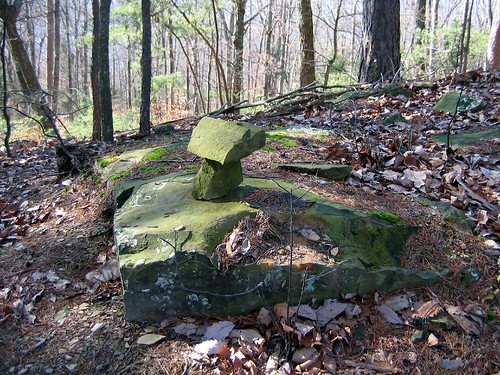
Weathering rocks, collecting moss.
(*photo credit)
March 10, 2014 Acid Rain: It Sounds Ominous -- and Is
We often like the sound of rain on the roof, for this means moisture is accumulating for the coming growing year. But what if that is acid rain? The excuse may be that all rain is at least slightly acidic, but the word bears degrees of intensity from slightly to severe enough to attack metal and erode rocks. Yes, today our cistern water quality can be affected when catchment surfaces (e.g., metal roofs) dissolve due to persistent acid rain. Silvicultural experts note that forests at higher elevations in the Blue Ridge Mountains and in ancient forests of Europe are damaged and dying. Medical research shows that acid rain in mist and fog can also have detrimental health effects on humans, animals and plants. Culturally, monuments of older and newer industrialized nations, from medieval cathedrals to the Lincoln Monument, are harmed by the assault of acid rain.
Using our native fossil fuels as an intermediate energy source before transforming to a renewable energy economy comes at a severe uncalculated environmental cost. Acid rain results from pollutants in the air, especially from burning fossil fuels. Lowering the pH (to greater acidity) is due to acidic sulfur and other oxides in the emission products of coal-burning powerplants and from autos and other causes. This phenomenon of acid rain damage was first detected in a noticeable way in Scandinavia in the 1950s and then throughout industrialized and northern Europe, and then to our own North American elevated-area forests and lakes in industrial regions. And problem areas are becoming a global phenomenon.
The Clean Air Act amendments of 1977 required new coal-fired plants to reduce sulfur dioxide emissions by 70 to 90%. Industry used scrubbers, lower-sulfur coal and new technologies, such as fluidized-bed combustion and limestone injection multi-stage burners; still we have damaging acid rain due to delays in Clean Air Act implementation, expanded fossil fuel combustion products, and delays in a renewable energy economy. In North America, acid rain is particularly acute in the Northeast U.S. and eastern Canada, which lie in the path of eastern movement of emissions from coal-fired facilities in the Midwest and the Ohio Valley. Lakes have deteriorated in quality and fish habitat has been endangered. At one count, some 48,000 lakes in Ontario province alone were regarded as threatened. In nine rivers in Nova Scotia there is no aquatic life to speak of and this is due to acidity.
Coal-using utilities have insisted that they cannot afford improved acid-rain-control measures, and that their costs would be in the billions of dollars to implement changes. This hurdle together with available fracked natural gas is rapidly spelling doom to new coal-burning facilities as electricity from coal decreased from 33% in 2005 to less than 21% at this time. Acid rain damage is a good argument for a renewable energy economy.
Prayer: Teach us, Lord, to acknowledge what we do to your vulnerable Earth and give us courage to make necessary changes.
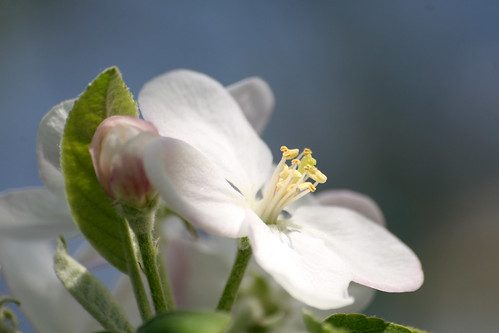
Apple in bloom.
(*photo credit)
March 11, 2014 Introduce a New Fruit Tree Variety
Johnny Appleseed Day is a perfect time to talk about apples, a fruit we are going to focus on in 2015 with "365 ways to enjoy apples." Planting a variety of fruit and nut trees can enhance the environment, and for average green folks (non-specialists) is more balanced than focusing on a single type of fruit, no matter how advantageous. You do not have to be an orchardist to choose variety; intersperse trees where space permits. This makes the tree planting a challenge and an opportunity to use the overlooked small spaces on your grounds. Some talk about north-facing slopes for later blooming, but that may have limited applicability with seasonal warming coming earlier.
Variety allows a longer fruit season. In Kentucky, cherries along with strawberries start the fruit parade in late May and early June; plums together with wild raspberries begin in late June (though with proper choice the plum season can go a longer time); July is blackberry, peach, and early apple season; then apricots and mulberries come in August; later autumn apples and grapes in September; various late apples, pears, and paw paws follow; and, last of all, the persimmons, that can bear into winter.
Variety allows fruit to be available when one type gets damaged or destroyed by a frost. The blooming at different times both gives the pleasant appearance of blooming trees for more of the springtime and allows the possibility of some fruit when other varieties fail to bear in a given year.
Variety can be coupled with the dedication of particular trees chosen by a donor in memory of a relative or friend -- and the connection to the person remembered by a particular fruit or nut. Choosing variety, whether of a fruit, vegetable, herb, berry or nut is very enjoyable. The catalogs are filled with mouth-watering pictures. Though your own growing spacial situation may differ, choosing and hoping for the best is a joy in tree selection. Variety permits people to have the great pleasure of harvesting fruit when they visit during part of the growing year, along with the satisfaction of eating what they pick. When there is a grand harvest of one variety, the pleasure soon gives way to work, for it takes effort to pick, prepare and preserve abundant fruit.
As for commercial sources of fruit trees, I could suggest my favorites, but that might influence readers who could make better selections for their micro-climate. Rather, learn from local growers, county agents, and sales personnel. Should the tree die, you will most likely get a replacement from local folks -- though some national groups do very well in guaranteeing a tree after planting. Select disease-resistant varieties to minimize any temptation to spray pesticides. Often having two of a certain type of fruit tree or two close relatives allows cross-pollination.
Prayer: Lord, you gave us great variety in our world. Help us to continue to celebrate this through our tree selections.
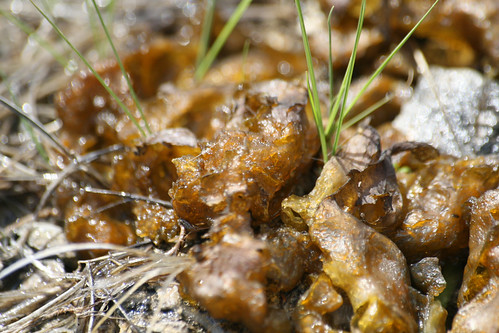
Microbial clump (cyanobacteria). Cedars of Lebanon, TN.
(*photo credit)
March 12, 2014 Consider Fasting for Others
We know from Mark 2:18-22 that people came to Jesus and asked a rather serious question: Why did John's disciples and Pharisees fast but his (Jesus) disciples did not? His reply was "How can the guests at a wedding fast as long as the groom is still among them?" Really, Jesus admits that there are times to feast and times to fast, not that fasting is inferior or even unimportant. We each need to fast in order to gain self-control, a practice that our people of plenty have in very short supply.
Our fasting becomes a way of reaching out even when done as we heard on Ash Wednesday that we ought to keep our fasting somewhat private. Granted, fasting is a way to discipline, is part of our observance of Lent (to the degree that we are able by health, work, or age), and is a good way to rest our stomach and take off unneeded body fat. Refraining from good things, including the foods we like, is a means of gaining personal spiritual, mental, and physical wellbeing. Fasting is good for the individual soul, but can we go a step farther and make fasting into a social practice, even if not publicly announced?
For years near Thanksgiving, Oxfam has encouraged thousands to observe a fast for the world's poor and to send the money saved to theirs or other world hunger agencies. Last year on December 10th Pope Francis called for all of us to stop at noon and pray for the hungry. Such consciousness-raising practices allow all to become aware of amount and nutritional value of food consumed, how food choices differ from that of people in other ages and lands, and how little food more than a billion people of the world live on. Fasting then takes on a different direction: we fast for more than ourselves; the practice resembles giving aid through walk-a-thons and concerts. Fasting takes more effort than giving in charity. We feel it when we fast and that feeling stays during the entire period. We suddenly become aware of those who go on fasts for reforming institutions. Fasting can couple a personal exercise with a social dimension involving solidarity with others.
A secondary social effect needs to be introduced publicly, namely that we fast from certain resource-intensive food items such as meat products and commercially processed snack and other prepared foods. Thus, refraining from such items for the sake of the hungry, when many cannot afford the luxury of eating meat except on rare occasions, makes this a meaningful practice. We live in a nation where many have never said "no" to goods demanded here and now. Fasting can become a public practice whose practitioners are witnesses to what our culture needs to consider in social and individual restraint. This is much like abstinence from meat in earlier times. All of us are invited to fast in Lent and beyond in order to become countercultural witnesses to a consumerist-filled world of spend and grab for more.
Prayer: Lord, allow us to see value in occasional fasting and to speak up for that practice in our sated consumer culture.

Red-spotted newt (Notophthalmus v. viridescens).
(*photo credit)
March 13, 2014 Good Samaritan Day's Lenten Hints
We all imagine that when bad times come to another we will be a "Good Samaritan" coming to the rescue. The Good Samaritan parable is perhaps Jesus' most famous one and involves coming to the help of a wounded robbery victim. By Jesus' accounting, this victim is ignored by two other passersby, and to top it off the helping hand is a despised foreigner. Recall that this Samaritan is the answer to the question posed to Jesus, "Who is my neighbor?"
Good Samaritan Day comes in early Lent, when we may still be seeking to settle on a perfect additional action or restraint to do this penitential season. We may think about giving assistance to a neighbor. The emphasis is often placed on helping a distant victim in a poor country. However, just as Jesus extended "neighbor" to those of different religions or groupings so ought we to expand to a wider neighborhood. Let's consider extending "neighbor" to include the plants and animals that are being threatened on this planet, who are victims of human greed and habitat robbery, and are so easily ignored. They are our neighbors on this finite planet in a vast universe, and they depend on us to halt the threats that are of human origin. We know that environmental actions seem a little hackneyed, because all, even small tots, seek to do something "green." Where is the drama? Let's consider possible Lenten practices that seem trite, but are actualized by the contrite:
* Attend to the needs of wildlife: Feed birds and put up bird boxes for certain species; take part in bird counts or initiate wildlife monitoring programs; create your own or a community wildlife sanctuary; support animal shelters and animal protection groups; put bells on your cat and neuter pets; start a compost bin and be good to the earthworms; take care of pets while a neighbor is away; and post "no trespassing" signs to omit unwanted hunters.
* Protect wild plants: Assist in removing exotic invasive species from public lands and right-of-ways; plant trees, especially on or around local Arbor Day, and enlist others to do the same; insist that wilderness areas be left pristine; join with others to maintain nature trails; protect and admire, but not pick wild flowers; and report trespassing off-road vehicle drivers.
* Domestic and wider environmental actions: Clean up a section of littered road or waterway; expand recycling efforts; report litterers so that they will be compelled to clean up their own mess; convert lawn into wildscape or gardens; write Congress about strengthening the Endangered Species Act; promote the renewable energy economy; read a book on environmental needs in our world; give some time to teaching environmental issues at a nature center; encourage youth to engage in outdoor hikes and camping; support those who seek to improve nature reserves; and oppose clearcutting on state and national forestlands.
Prayer: Help us, Lord, to see plants and animals as neighbors who are victim to the greed of the unscrupulous.

The nard flower, as seen on Pope Francis' coat of arms, representing Joseph,
Patron of the Universal Church.
(*photo by Perla Roques, Creative Commons)
March 14, 2014 Pope Francis' First Anniversary
What a year with the papacy! A transforming event was the election of the new pope last March and a host of changes. These began the very first moment when he chose Francis for a name. At that moment the new pope asked the people to pray for him in a most humble manner. He was one who soon showed a difference -- riding a bus to his residence, paying his hotel bill in person, and moving into the local hostel rather than the Papal Palace. From the start a new transformation of papacy with its emphasis on democratic communication and not noble domination was evident. Other Catholics ceased being a king's subjects and became fellow citizens in bringing Good News to all our brothers and sisters.
Here is a Pope who speaks in a forthright manner -- though others who preceded him did so likewise. He gets to the heart of the issue -- the terrible hunger on the part of some who cry for food, and the vast and growing inequality of the wealthy bolstered by weak-kneed legislators who know the power-drivers who feed them. The thirst for power and possessions knows no limits. In this system, which tends to devour everything which stands in the way of increased profits, whatever is fragile like the environment is defenseless before the interests of a deified market, which becomes the only rule. "Evangelii Gaudium" #56
A curtain on believers seems to be lifting through his plain-spokenness. What is so evident is that a world was shocked by the stepping down of elderly Benedict XVI (the first resignation of a pope in 600 years) and a younger and stronger replacement -- God's gift to us all. Pope Francis has a ministry of simplicity by foregoing an expensive private vehicle. Our own prayer is that he abides by security rules in his rush to meet, embrace, bless, and wash the feet of everyone. From his fast sprint the world seemed to respond, as evidenced in his World Youth Day trip to Brazil.
Pope Francis has been an Earthhealer from the start -- being on our Facebook page prior to his election. He is committed to the environment in every way; he plans to add to what has already been said off the cuff and in Evangelii Gaudium, and promises when time permits to write an encyclical on the environment. He links an understanding of a dysfunctional world economy with what is happening through climate change. He perceives the gross inequality in the world of a thousand billionaires and a billion people who would crave a yearly thousand dollars.
Pope Francis is also concerned about maintaining world peace; this he showed in his prayer evening at the Vatican last September, when military intervention was expected in Syria following the use of chemical weapons. In many ways, his and 100,000 participants at St. Peter's and the countless millions throughout the world bore fruit when diplomacy overcame military action.
Prayer: Lord, send special angels to protect Francis who is so quick at plunging and mingling with the crowds.
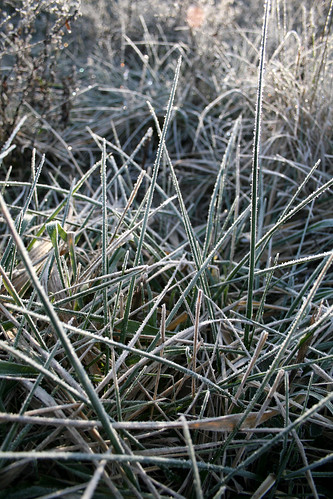
A dense network of frost-covered grasses.
(*photo credit)
March 15, 2014 Observe Freedom of Information Day
"We have got to have more information!" "We suffer from information overload!" Can both of these statements be simultaneously true? Rapid information dissemination is of recent origin and makes us jaded for more, while at the same time not allowing us room to prevent raw information from giving us indigestion. Two centuries ago, the time required to exchange information with Europe was months and depended on the speed of the sailing craft crossing the Atlantic. However, a few decades later faster ships were running on steam, telegraph wires crisscrossed the landscape, and eventually a transatlantic cable sped information flow even faster. However, during the Civil War reports (to the degree the government allowed) only took minutes via a telegraph teletype operator. Even then the Generals delayed news of the Cold Harbor Virginia battle because information of the horrifying death toll would overwhelm the public.
When I was young, the attack on Pearl Harbor was known the day of the attack; we followed the Second World War on a daily basis to the degree the censors permitted. Still, we as citizens did not know about Nazi concentration camps and degree of death tolls of Jews, Gypsies, and Polish leaders until near the war's end. Such information was not available, and we began to realize that the communications speed is only one component of which controlled public access is another. Much depended and depends on governmental release of data findings and a willingness to disseminate information. Power rests in both receiving and sending information.
Tomorrow, on Freedom of information Day we should ask some serious questions. Did the Bush Administration in 2003 know that Iraq had no weapons of mass destruction and deliberately keep this from even the Congress? What about all the victims of recent drone strike attacks? How much methane is released in the new fracking phenomenon sweeping our country? What are definitive counts on drug-related deaths in Appalachia? And is it true that ours is a land of complete openness to information, or is much info withheld?
The Internet is certainly a valuable tool for disseminating information. This website is meant to be an information-generating outlet, so we have posted ethnic and other statistics along with material on a variety of environmental issues, which may be quite controversial. The Internet can be a source of just such information, but there is another side: if the information is not checked out, it may be slanted and even destructive to targeted people. Not everything on the Internet is valid. One participant may favor trivia and know all that Google can present -- and yet be unwise. Truly, information may clutter reflection time and paralyze our decision-making faculty. Lenten self-control also applies to information selection, assimilation, and digestion.
Prayer: Lord, allow us to know how much is enough and how to find time to digest the right information at our fingertips.

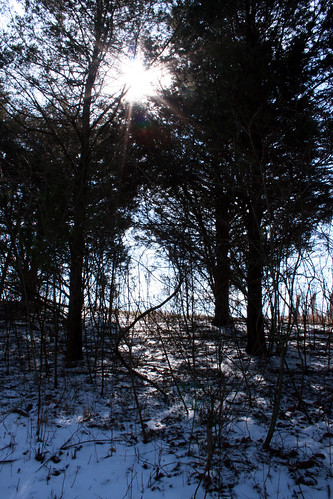
Gentle sunlight filters through Eastern redcedar grove.
(*photo credit)
March 16, 2014 Mount Tabor and the Golden Moment
There in their presence he was transfigured; his face shone like the sun and his clothes became as white as the light. (Matthew 17:2)
Each year on the Second Sunday of Lent we reflect on the event of immense significance in the journey of Jesus to Jerusalem. This event described today is a pause in the journey, a foretaste of glory that will come after enduring the immediate future.
The Setting. Mount Tabor is a beautiful mountain overlooking the Lake of Galilee and the fruitful rolling land. Though the flowers are not yet in full bloom, the place is naturally a beautiful location. Here Jesus is given a choice moment where his glory so cloaked by human trappings, suddenly unfolds before his closest disciples. This bit of Earth radiates its Creator, a spiritual reflection of the divine in our midst, a stopover that is glory shining through, a special sacred place in a Holy Land.
The Event. Each liturgical year the Transfiguration is really celebrated twice: once, in high summer (August 6th), when the glory of the Lord is shining with full foliage, and once in Lent when Jesus and disciples need consolation to carry through the upcoming Calvary experience and the sure knowledge that future glory will shine beyond the withering ignominy of what is soon to occur. The Transfiguration event is recorded in all three Synoptic Gospels, as well as in St. Peter's second letter, truly a pause that refreshes.
The Significance. Jesus takes the three disciples up the mountain; this harks back in time to Moses going up Mount Sinai and receiving the Law. Here Jesus stands in center stage and talks with Moses and Elijah; thus demonstrating the central role of Jesus in salvation history; he is greater than the supreme lawgiver and
the great prophet and the Father affirms him as the beloved son. Jesus' face is radiant and shines like the sun. Peter's reaction is to say -- "It is good for us to be here"; in our everyday language he could have said -- "Let's snap a photo;" he offers to erect a stone memorial with three tents, referring to giving the Law as commemorated in the Feast of Tabernacles. God the Father confirms the solemn event while disciples are paralyzed by fright.
The Consolation. The Transfiguration gives us all courage. Jesus needs spiritual fortification for what was to come in his suffering and death -- and shaken disciples were given a foretaste of a future glory after their trials. To be transfigured is the reality that radiance shines through the ordinary daily life of each of us, for hard times precede final glory. Transfiguration is the vision of a better world seen from a hilltop vista. We need our moments of consolation, and an all-provident God provides them. We are not spiritual marines acting tough; we need a good word, a hug, and a smile from the ultimate Gift-giver.
Prayer: Lord, help us to continue to find new meaning in this and every event -- a transfiguring of life into new life.

Greenhouse blooms await the arrival of Spring.
(*photo credit)
March 17, 2006 The Luck of Irish Americans
My first and virtually only stage appearance was in an early grade, and I was to act like an Irishman with a brogue. The audience roared and I simply couldn't figure out what was so funny. They all knew my family and that I didn't have a drop of Hibernian or Celtic blood in my veins -- but I was not yet so enlightened. So much for an introduction to being different at St. Patrick's School. With years, that difference became more evident. It became a love/hate relationship: some things Irish were great, but not clannishness. Yes, clans fade with time, as have diluted ethnic neighborhoods, and cultural differences have waned. As for acting Irish, I am from the same school that the Clooney family attended when in Maysville, and Rosemary, Betty, and brother Nick and his son George Clooney were proud of their hometown origins and have used their Irishness well.
For some years, the Irish have been the third largest ethnic group in the United States, though the Hispanics are coming up fast. Included among the category "Irish" are many Scotch-Irish people, for the names and culture are so similar and the hyphenated grouping of those coming to America from Ulster is often overlooked even by descendants. Irishness is a broader term and perhaps today includes most people with some degree of Celtic blood, except for some French Canadians (Britons) and Scottish, Welsh, Cornish, and Manx who are extremely proud of their ancestry. Once in America, the Irish congregated for a period in Atlantic Coast cities, but many moved inland quite rapidly and worked on railroads, farms and eventually settled in towns. An Irish optimistic demeanor and knowledge of English, plus an ability to get along well with others, led to entry into politics, industrial management, and the service sector, law, teaching, healing and the religious life.
On St. Patrick's Day we know that being Irish is still regarded as a point of pride. A large number return to the ole' sod to visit the homes and graves of ancestors. Many enjoy celebrating this day by wearing green and gathering for Irish songs and dancing. St. Patrick's parades grace American cities and small towns, though weather can sometimes fail to cooperate. I enjoyed going to such parades when studying in New York; there was a special sort of friendliness in the Big Apple on St. Patrick's Day.
The Irish enjoy a good joke, a hearty meal, a little imbibing, and a nice March 17th. Perhaps the Irish recall they could not celebrate Christmas in Puritan New England until after the middle of the 19th century. Cultural differences in America led to disagreements when Know Nothings targeted the Irish, refused them jobs and made life rough until the Civil War. Irish-Americans turned out to be good warriors (Irish-blood was spilt on both sides in that conflict). Through upward mobility Irish-Americans changed American ethnic fabric. John Kennedy helped cement acceptance, but other good-natured souls contributed along the way.
Prayer: Lord, let every group shine on one or other day.

EXTRA THIS MONTH! SPECIAL ISSUES REFLECTION
Healing Earth: A Call to Eco-Revolution1
Al Fritsch, SJ March 2014
To Pope Francis -- and all fellow believers:
We share a deepening concern about human-caused climate change as the window of opportunity closes on effective action. Individual conservation and simpler lifestyle modifications are certainly needed, but collectively will not address the core causes of this crisis. This goes beyond popular discussion, personal choices by the inspired, and a host of innovative ecological studies. The environmental crisis has deep roots that we must realistically address and be prepared to make radical changes in a dysfunctional System for the sake of all our brothers and sisters who are poor. Believers in Earth's future must be ready to question, critique, and confront a consumer-oriented economy that is generating pollution and waste of resources. - Click here to continue reading...

New life emerges from the forest floor.
(*photo credit)
March 18, 2014 Seeking Balance during March Madness
Kentucky is an enthusiastic sports state as are many others in America, except that sport and teams of choice differ. In Kentucky basketball is king. Schoolkids and adults go wild at tournament time in March. Teams vie for end of season honors and student fans (both high school and college) turn out in mass to cheer as victors and commiserate as unfortunate vanquished. Host cities are turned into migration centers for a sea of joyful fans. Radio and TV coverage is comprehensive; banners abound; carloads of shouting youth move up and down roads and streets; fieldhouses and arenas turn into beehives, and referees hide after a disputed call.
During this sports' mad month doctors advise those of us with weak hearts to refrain from attending such high pressured events. It is a regular occurrence that heart attacks happen at such events even when watching favorite teams on TV. Why all the artificial stress? My own attendance at a University of Kentucky game brought the conclusion, "Never again." The adrenaline rush was far too great. It has much to do with joining the crowd and losing control over oneself all for sports "enthusiasm." Where is the balance in our lives when we enter a mob and act like part of it? Fans are convinced that hollering louder will change the course of events. In fact, earlier this season a minor earthquake was recorded coming from the sports arena due to a single crowd reaction at a game.
Balance to such maddening conditions comes in several ways: stay away when pressure is too great; resolve to enjoy the sport for its own sake and even cheer opponents when they do a good job; consider that sports play is something good and that a victory to the chosen side is not an end, but additional reason to cheer; don't let competition overwhelm the psychological balance that always must be present; and challenge the unbalanced fans during saner moments before or after the event itself. Why lose balance over spectator sports when supporters expect players to hold their "cool" (stay in control)?
This periodic madness raises more fundamental questions about sports in this age: What about the sports industry with its high-paid salaries, mega-stadiums built to accommodate wealth in special suites, restricted scholarships for talented athletes who are not academically inclined? How is this madness different from Roman circuses with lions killing Christians and gladiators slaying each other? What does loyalty mean in the frenzy of a competitive event and uncontrolled "fanhood"? Is it healthy for an over-sized and half-boozed spectator to suddenly erupt over a call by a referee? Has fair play and charity been lost? How about chaplains sitting on the bench with players and acting like one of the rest? Why condone madness? Isn't it more sporting to go out and involve oneself in personal exercise on a walking trail, at a squash court, or in an exercise room? What about watching seals snooze while betting which one will wake first? It's a chance for fresh air.
Prayer: Lord, give us courage to question sports' madness.
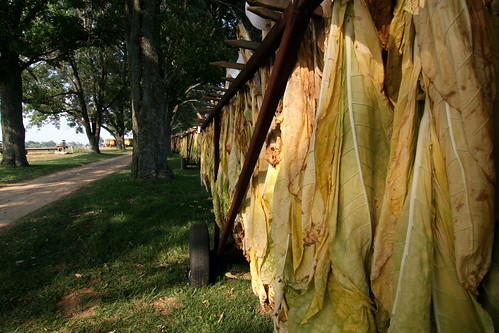
Tobacco harvest in Kentucky.
(*photo credit)
March 19, 2014 Awareness of Substance Abuse
Kentucky is famous for its burley tobacco, bourbon whiskey and, more recently, for growing marijuana. All three of these substances have serious behavioral consequences if misused. The general rule among more tolerant Kentuckians is: use in moderation and overuse is unhealthy. However, these three substances differ in effects and addictive behavior, and are treated separately.
* Tobacco has proven to have major, unrefutable health consequences for those who become addicted. It is evident to set some ground rules: don't start smoking; keep the material away from youth; if started, use with moderation; never smoke in presence of non-smokers; and try to quit the habit ASAP. Let's enforce regulations against promotion of tobacco to youth, along with cessation programs paid for by tobacco companies and taxes.
* Alcohol is a substance used in social celebrations to loosen spirits. Some handle alcohol quite well and others do not. None of us can be cavalier about drinking strong alcoholic beverages. Some use Kentucky Bourbon to spice candy, mock mince meat pies, fruit cakes, and even ice cream to a small degree, and others bake delicacies with bourbon, with limited amounts used for medicine in flu season. "Moonshine," a supposed Appalachian specialty, has been replaced by more lucrative drug sales. With alcohol the state must control sales, restrict access by minors, and enforce laws related to driving under alcoholic influence. Continue taxation of products sold, and start cessation programs through taxes raised. Encourage Alcohol Anonymous programs.
* Drugs -- Many advertised "soft" (some prescription and over-the-counter) drugs are tolerated by a medicine-demanding general population willing to take a dozen medicines and supplements at one time. Hard drug use is a chronic problem in America and especially in rural Appalachia, where overdosing is a leading cause of death. Yes, a national cavalier attitude contributes to the total drug culture. Colorado and Washington have decriminalized marijuana use but other states are waiting to see what happens. Strong drugs must be regulated; so should "weaker" drugs, including forbidding advertisements for medicines. Controlling hard drugs (heroin, methamphetamine and prescribed drugs like oxycontin) is often wishful thinking. Requiring purchase records must become routine.
Tobacco, drugs, and alcohol are expensive, habit-forming, unhealthy and threatening to various body organs, and cause accidents when used improperly. Half of accident fatalities and homicides are drug-related; a quarter of suicides are alcohol- or drug-related; alcoholic imbibing has a deadening effect on human creativity, with work hours lost and less ability to contribute to society. Drug and alcohol users are seven times more likely to be separated or divorced; and child and spouse abuse heightened. Drugs and alcohol are gateways to more abuse.
Prayer: Lord, teach us to respect all harmful substances.
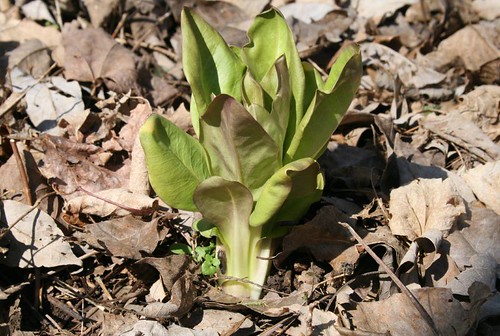
Discovering the March emergence of American columbo, Frasera caroliniensis.
(*photo credit)
March 20, 2014 Champion Non-Smoker Rights and Related Issues
Smoking is hard on the health of the smoker and of those near to the smoker. Evidence exists that people near to smokers are at risk and thus smoking has a social component. Those near to smokers can also develop smoke-related illnesses such as emphysema, heart disease, and lung and other forms of cancer -- only not to the same degree of severity or frequency as smokers themselves. However, any disease is severe enough in whatever form, and non-smokers have a right to clean air and enjoyment of the air commons.
When a smoker, I overlooked that my practice infringed on the rights of others, including my own non-smoking mother. Today, those who are near but do not smoke are better protected because the number of non-smoking areas multiply by the day, and smokers are subject to fines for not observing certain regulations. It is not enough just to "deodorize" or scent a smoked up room with an aerosol spray; these simply mask carcinogenic smoke, but non-smokers are still subject to the assault of tobacco smoke. Opening windows and airing out a place is better, but hardly ever gets rid of the residual odor and some smoke-clinging substances on rugs and other fabrics. Non-smoking space needs to be preserved and protected.
What about the non-smoking fetus in the smoker's womb or the infant in a smoker's home? Certainly the state has a right to remove an innocent party from such danger, but ultimately it is the little one's mother who must refrain from smoking. The task is to convince that mother of dangers involved but is it ethical to incarcerate her in a smoke-free compartment during pregnancy? Her rights need to be protected while our responsibility is to impress upon her the need of her offspring to have a clean environment. Amazingly, this problem approximates that in which pro-life and pro-choice forces battle. It becomes our responsibility to explain to others hazards of smoking and yet allow them the opportunity to do the right thing. Note that hospitals are now extending outdoor non-smoking areas further and further from the front entrance. Such measures are meant to ensure clean air for the innocent and health for all concerned.
One bumper sticker says "Criticizing my smoking could be harmful to your health;" cute and part of the issue. The "right" or license to smoke is the right to engage in a form of entertainment; like other forms of recreation a certain risk is involved. Still, this is the free choice of an agent who just might live to 80 years without a cough -- though we doubt it. Pure air is a right to all; when a smoker lights up in the great outdoors, dilution is such that there is little social effect; when that same smoker indulges in a closed space, a deliberate infringement on limited air ensues and this neighbor has a right to fresh air. A right to pure air exceeds a "right" to foul the air.
Prayer: Lord, help us resolve supposed conflicts of rights for the good of all, especially when infringing on others' rights.
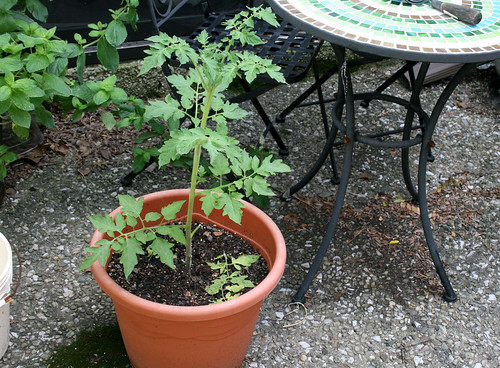
Container-grown plants as decor and food source.
(*photo credit)
March 21, 2014 Daily Greens through Container Gardening
Many aspiring gardeners are limited in space and/or mobility and yet want to have a daily supply of greens (lettuce, spinach, endive, etc.). One answer is a container garden that can furnish materials the year round by growing veggies in pots and pans. Spring can be a time to fill decks patios, and south-facing exterior stairs (provided not dangerous) with some containers of growing plants. Be creative and grow even when limited by space shortages. The following suggestions may help:
Size of containers. Use larger planters such as sawed off "half" barrels, tubs, or large cans. Select a size according to the variety that is to be grown: a larger planter will be needed for tomato or pepper plants than for greens or many herbs;
Plant selection. Choosing varieties is important when space is very limited. Grow what you like best within certain limits and forget about growing sunflowers and corn; leave bulk crops to open field gardeners. For salad lovers, containers are perfect for growing mustard, spinach, kale, lettuce, endive, and Swiss chard, along with many herbs that do not take up much space. These can be started now before the outside weather permits and moved outside in a few weeks. Except for radishes and the onion family, most root crops could be better raised with more space;
Soil selection. You should provide a drain hole or outlet so excess water can escape. Use the best soil you can obtain, usually interspersing your own compost with soil obtained from a field or a garden supply outlet. Select rich soil and types low in clay;
Siting. Place most plants in sunny places. Save less choice spots for greens that do not need much sun. Have vining plants such as cucumbers run up a trellis on the northern or eastern end of the location and stair step them down in a southern and western direction with smaller plants to the front;
Care. One needs to know how much to water and to ask a neighbor to look in on needs while away on a trip. Usually container plants will require more watering in hot dry periods than will plants in regular gardens unless the container walls are protected from heating and moisture loss. An advantage of containers is that they allow easier weed control; and
Rearrangements. An advantage is that planters may be bunched together when the plants are young and then thinned gradually as plants need more room to grow, thus maximizing the use of space. They can be arranged so as to place flowering or fruit-bearing plants in the most aesthetically pleasing design. Containers can be moved indoors in the late summer before frost, but that is sometime in the distant future. Let's start now with springtime.
Prayer: Lord, inspire us to conserve well our limited space
and to see value is touching the soil.
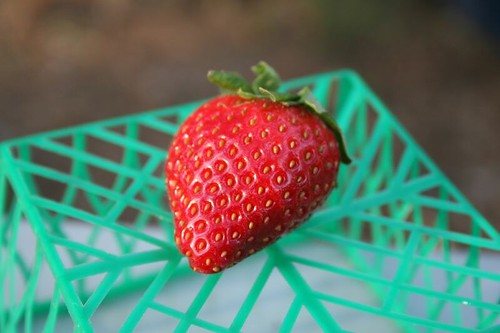
The beauty of a ripe strawberry.
(*photo credit)
March 22, 2014 Food Tripod: Economy, Nutrition, and Local Produce
Yesterday's reflection on container gardening for those with limited space offers an opportunity to establish a food balance in the home. This balance is directed towards saving money (and growing greens is an economy practice), getting the best in nutrition (and nothing can beat fresh greens), and fostering local produce production (many of the ills related to possible fresh veggies come from distant sources). In fact, three legs are very essential to a standing stool, and lack of balance occurs when one or even two legs of the food tripod are missing. Balance demands equal presence of all three. It's good to focus on food economy, but does this mean filling the menu with unhealthy food? For those who can afford the cost, is it good to bring the produce from a distant less controlled source and risk contamination? Balance is the golden food rule and deserves adequate consideration.
Economy -- For many Americans and those in other poorer lands food bills draw special attention, for money is limited and food is essential to life. Unfortunately, many adjust tight budgets with pasta and sweets that give temporary relief and yet lack proper nutritional value. Often wholesome foods are outside of a poor person's budget, or they are not normally found in grocery supply places in poor neighborhoods. Thus, supplementing diets with some grow-your-own foods is one alternative that the more adventuresome find promising and the visionary see beyond the horizon. Others learn the hard way to do one's own cooking instead of buying expensive commercially prepared foods. Still others who watch their pennies buy bulk and surplus supplies when plentiful and in season and preserve food for the off-season.
Nutrition: Much has been said on March 1st during the start of Nutrition Month about food choices, for if these are properly regulated the health of our nation's young and old would show noticeable improvement. Poor nutrition is the root of obesity- related illnesses, and resulting escalating health costs. Even when the contrast of good and bad nutrition is known, many consumers will overlook or excuse themselves for the chance to further indulge in favorite snacks and junk foods. A major challenge awaits conscientious budget watchers who desire to eat solely wholesome and nutritious food.
Local Produce: The third tripod component is the most challenging for urban dwellers who are even familiar with the ordinary rudiments of food economics and nutrition. Where can this person garden? Home gardening is practiced by over 30 million individuals and groups. In an age of large supermarkets with thousands of selections, much comes from distant sources via complex food networks. Local produce by small farmers is ignored due to lack of volume and quality control. Eating totally from local produce is difficult but done in some farming communities.
Prayer: Lord, teach us balance in all that we do in this troubled world and to establish this balance in food practices.
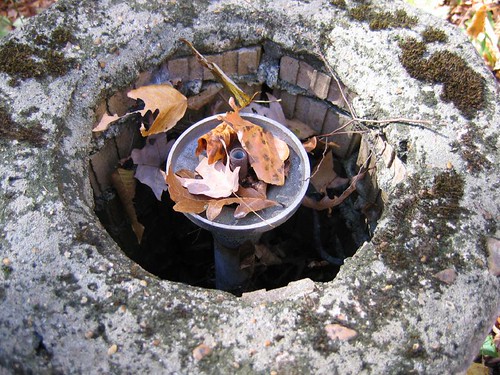
A forgotten well-fed fountain, along the Natchez Trace.
(*photo credit)
March 23, 2014 Reflections on Faith: The Woman at the Well
God is spirit and those who worship must worship in spirit and truth. (John 4:24)
On this Third Sunday of Lent we reflect on the Samaritan woman at the well when Jesus seeks a drink of water; the conversation leading up to the village coming to see who claims to be the Christ, the Messiah. In fact, his Messianic role is shown clearly in this account, and we need to see how it applies in our own lives, for this is more than a historic narrative.
Jesus is thirsty. He is honest about wanting others to interact with him. This goes beyond a physical desire for water to a spiritual desire to bring souls to God. Are we willing to listen and hear Jesus calling out in thirst and respond personally?
Jesus is direct and plainspoken. He tells the woman all about her past life in an instant, that the Jews worship correctly and that this nearby mountain is not that one. He goes on to say that even this discussion will soon be transcended as to worship space. Are we open to expanding our visions of what must change?
Jesus is living water. He is the source of all graces through which we act and so is the wellspring of our lives. Do we see that the waters of Baptism are meant to be a manifestation of freshness and the way to come to the divine life? Are we to look more deeply into our faith and our daily spiritual journey?
Jesus elicits response. The woman at the well becomes the first missionary taking the Good News to others in her village in such a convincing fashion that they come to see Jesus. She raises an issue that we must address. Is our testimonial to Good News sufficient to bring out those seeking to find Jesus?
Jesus' words elicits urgency. His mission is so pressing that he has lost his appetite, for his food is to do the will of the one who sent him. Ought we to have a consuming zeal that goes beyond physical needs to partake in spreading the word to others?
Jesus is willing to stay. He accepts the invitation to come to the village and remains there for a length of time. Do we give time for the Lord in our lives? Are we to sense the desire of others to communicate and respond by changing our schedule or itinerary to share time with them?
This episode is a journey in faith, and the richness of the story cannot be fully tapped in a lifetime. Lent is that period when the Lord gives us space and time to break out of old ways (as was the case of the woman at the well and the disciples) and find Jesus in our ordinary life journey.
Prayer: Lord help us to reflect ever more deeply on the passages of Scripture and find true nourishment in this quest.
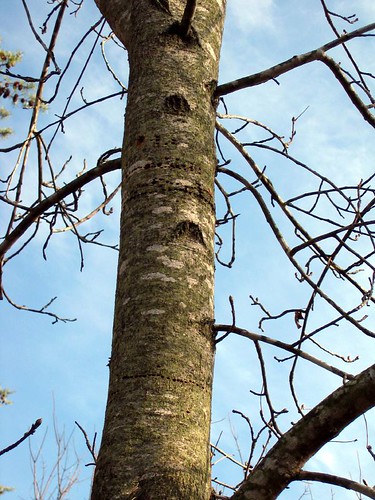
Blue skies grace a backyard daydreaming scene.
(*photo credit)
March 24, 2014 Protect Domestic Silent Space and Time
One theme in our book Reclaiming the Commons is an often overlooked area of the reality of silence and sounds. A needed tradeoff in life is to create an environmental compromise for all who share an environment that could be domestic as well as communal in a local or wider sense. Domestic dwellings need regulations to permit those wishing to rest to get quiet time. Yet we need space and time for all to have the freedom to move, converse, sing, dance, and authentically create and endure sounds of many sorts. The compromise for joint use of space and time extends from the domestic scene to a human and even wildlife world.
Sound when discordant is noise, something disturbing to many. Noise creates extra tension among residents and leads to loss of hearing and is even regarded as sound pollution, especially when invading another's silent space. By using available commercial devices noise can be properly monitored. This involves measuring the volume of the noise, the recorder's distance from the source, and in cases of recording devices, the time when noise occurs. Sound is measured in logarithmic units called decibels (dBA), which go from zero where humans start to hear to over 140 where noise causes pain (certain rock and roll concerts). Permanent hearing loss could occur with continuous exposure at approximately 85 dBA.
Source Sound level for operator in dBA
Inside home:
Refrigerator 40
Floor Fan 38 - 70
Clothes Dryer 55
Washing Machine 47 - 78
Dishwasher 54 - 85
Hair Dryer 59 - 80
Vacuum Cleaner 62 - 85
Sewing Machine 64 - 74
Electric Shaver 75
Food Disposal 67 - 93
Home Shop Tools 85
Outside home:
Electric Lawn Edger 81
Gasoline Power Mower 87 - 92
Gasoline Riding Mower 90 - 95
Chain Saw 100
Car Stereo up to 120
Inside airplanes 60 - 90
Motorcycles 100
New York Subway up to 101
--------------
Home controls of noise can be challenging, and yet achievable in a well-ordered home. External noise control, while beyond an individual's singular efforts, can be achieved by a well-ordered community policy created through cooperative efforts. Cotton plugs are virtually useless but well fitted, commercial earmuffs worn by airport workers are effective.
Prayer: Lord, give us the grace of compromise with those
seeking silence and those who need time to give forth sound.
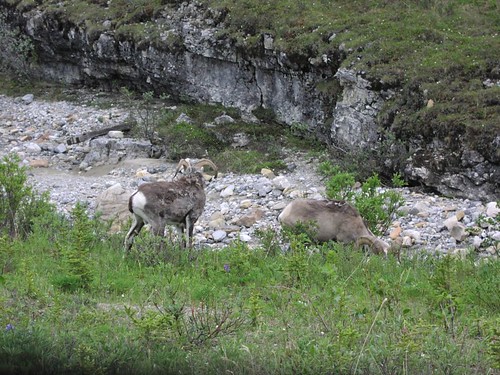
Stone sheep, northwest Alberta, Canada.
(*photo credit)
March 25, 2014 The Divine Takes on Human Flesh
The Word was made flesh, he lived among us, and we saw his glory. (John 1:14)
Christians believe that today a mystery starts to unfold, the likes of which the world had never seen, a critical moment in human history when the Divine comes among us -- so that we might enter divine life. This event, the Feast of the Annunciation, is celebrated exactly nine months before Christmas Day. In Luke's Gospel the Angel Gabriel announced to Mary that she was to be the mother of the Messiah. In our Liturgy of the day we recite the Creed and genuflect at the words, "And by the Holy Spirit was incarnate of the Virgin Mary and became man." We hold this to be a sacred moment, prepared for and anticipated for millennia through the selection of a Chosen People in a Promised Land. The prophets called Israel back again and again to that sacred mission of preparing for the Messiah. Now, after centuries of hope he arrives, a critical historic event.
To "incarnate" means to be a living example, to personify, to put on flesh, to be an embodiment of. We hold most solemnly the fundamental truth and mystery that God becomes one of us in time -- and this is the celebrated moment, the Incarnation. We "incarnate" Christ when we make his ways part of our own life and the lives of others who observe or take part in our actions. We take the divine mandate to love others, to share with the poor, and to bring these mandates about in our own human actions. We are a chosen people in an expanded holy land. We make a divine mission public and become another Christ, and participate in his own mystery of incarnation.
Incarnate hope. Christ the liberator comes among us; he presents liberation to us, giving us a chance to participate in healing the wounds of sin all around us, including the environmental degradation to the Earth itself. Even when people are behind bars or on a hospice bed -- a joining of prayerful and hopeful hearts, whether through active work or passive suffering, is a joining in the action of Christ in our midst. They each share this enterprise of liberation in and through Christ, and so his coming is the long-awaited hope realized in space and time.
Incarnate action. By analogy, we "incarnate" Christ by being an embodiment of the Incarnate Mystery in and through our own lives. Christ is re-presented through our words becoming flesh in actions undertaken by godly ways. We become the opportunity for Heaven and Earth to meet in visible form through Good News concretized by us. Even in gardening we bring our ideas alive by what we grow. Extending to a world community we can realize a divinizing activity by beating swords into plowshares, and Mystery coming ever closer in visible form. In our collective Creed we profess our faith through godly deeds when Heaven and Earth kiss.
Prayer: Lord, help us to profess the Incarnation by living
your Word and helping to bring hope to those in need.

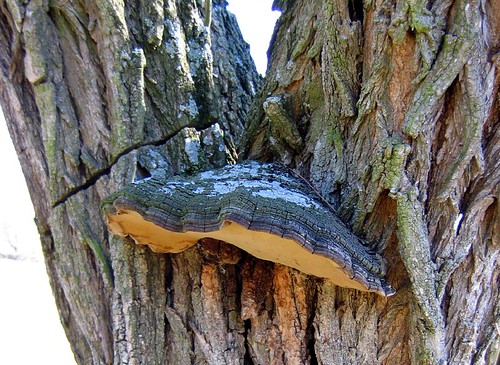
Fungal bract on weathered, old tree.
(*photo credit)
March 26, 2014 Must We Americans Continue to Import Oil?
Four months ago, the U.S. drilled and produced more oil than it imported, the first time this has occurred in several decades. A combination of fracking, greater energy efficiency, production of biofuels, and less driving were all contributing factors. And the rise of renewable energy production (wind, solar, geothermal, hydro, and to some degree biomass) is also leading to the promise of self-sufficiency. Can it be possible that the eight million imported barrels a day be eliminated as the newly developing world (China, India and all) scour the world for undeveloped resources? When this fracking method is adapted by other nations with plentiful shale formations, we can expect more and more adjustment of oil trade and scramble to use cheaper but limited supplies.
Energy independence? In the 1970s the Carter Administration set a goal of energy independence, and that has been mentioned off and on ever since. In fact, only in the few years with the factors mentioned above working to some degree, has this goal been reconsidered. Renewables are coming on strong; abundant and low-priced, fracked natural gas can be converted into transportation fuel; new biofuels are being produced; and cars are becoming more fuel efficient all the while. Even if America weans itself gradually from coal-fired powerplants and deliberately stops replacing aging nuclear powerplants, we have plentiful resources and supplies to make independence possible. And one hidden advantage is reducing the pressure to maintain foreign military presence to protect distant energy supplies. Military savings can go to infrastructure improvement and renewable energy development.
Possibility? A goal of energy independence fits with our green sustainable goals of furnishing bulk resources (food, water, building materials, AND energy) more locally. Of course there are limits to this in many areas where water is in short supply. The policy means looking elsewhere including nearby Canada for energy sources, but tar-sand petroleum is not regarded by greens as a fruitful option. Conservation in green-construction techniques and energy-efficient lighting and appliances is beginning to take root. This frees global petroleum for emerging industrial nations.
Will power? Much depends on America's willpower to change to energy independence (something analogous to crash programs to replace rubber and other essential materials when sources were cut off during the Second World War). The capital for conversion to energy independence is available. Let's call in trillions of dollars now in tax havens. Supply the job hungry with renewable energy technologies proven and becoming ever more efficient. Expand solar and wind electric production and reduce fossil energy needs in all sectors through efficiency, electric and hybrid vehicles, and prepare for an emerging hydrogen economy. It takes will power.
Prayer: Lord, give us the courage to launch into programs for
our local, national, and global good -- and to do this now.
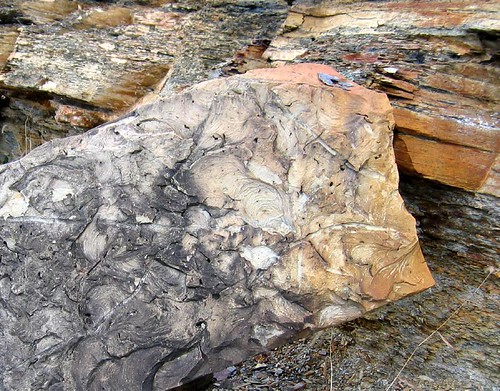
Fossils contribute to color and pattern in rock. Cave Run Lake, KY.
(*photo credit)
March 27, 2014 Art, Environment, and Earthhealing
This website has taken great pains in coupling texts pertaining to a broad expanse of environmental issues of the past decade or so with timely photographs of related subjects. In this Art Week we want to reemphasize the connection between art and protecting the environment with several of many reasons:
Respect for form, context, color, and design is a major component of good art; the same applies for appreciation of the treasure of nature all around, nature untouched and nature enhanced by respectful human touch. Artists are friends of nature and know that cooperative efforts involve sculpture, painting, architecture, and words as well as photographic capture. In showing respect, the artist is a gentle teacher telling the untrained to be respectful.
Hope is engendered in good art of all types from woodworking to clay-molding. Art takes us outside ourselves in the sphere of creative work and craft. If simple objects can become enduring treasures so can a damaged Earth be restored into precious surroundings in which to find quality of life. Art opens a horizon that beckons that future growth is possible and transformation is necessary for eternal growth of the human spirit. We need to be hopeful that climate change can be addressed and controlled, and art in crafted poetry and design has a way of saying this.
Beauty may be in the mind of the beholder, and yet beautiful art connects with a multitude of beholders who agree on certain artifacts. Our unspoiled natural environment is beautiful and earthhealers know that we need templates of what we want the damaged Earth to become -- an enhanced return to beauty.
Culture encourages and supports native art, and this becomes an atmosphere and surroundings where the environment is protected and preserved for the generations who are to follow. Healing Earth is likewise a heritage to be carried on and never allowed to be abandoned, and cultural words and actions are present to assist.
Consolation is a goal of good art from floral arrangement and costuming to song and dance. When attending to good art, the participant or observer comes to a feeling of wellbeing, so needed in a world of damaged landscape and polluted air and water. Good art from cuisine to archeological findings gives a spice to life that uplifts the caregivers and energizes protection of what at first appears lost forever. Art announces salvation and renewal and this is so at the heart of the crisis of our wounded Earth. Environment is not only the primary concern of those who expose damage; it is an urgent task of those who take it upon themselves to bear responsibility as change agents in a world needing the preservation and reconstruction of the economic and social order.
Prayer: Lord, give us the grace to support good art and to encourage artists to continue in their ministry of healing along with those dealing with technical environmental aspects.
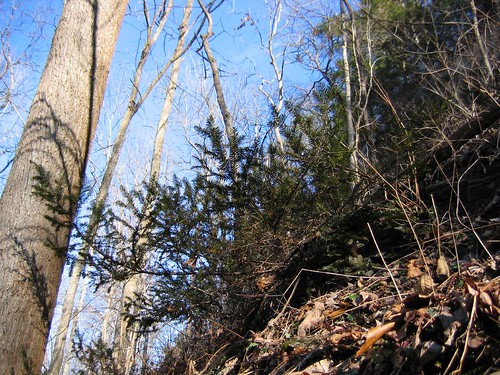
Taxus canadensis, rare Kentucky plant.
(*photo credit)
March 28, 2014 Ask Again: What Would Jesus Do?
At various times in our lives, we Christians ask ourselves what Jesus would do in certain trying circumstances. It may be reprimanding others for their lives, or a decision to attend or omit going to a certain function. While there are many ways of addressing these circumstances, we never achieve a degree of certitude to put our minds totally at rest. By what approach do we attend to this haunting question of this essay title?
The first approach is extreme in that it expects a miracle in which Jesus touches and talks to us in the manner of Paul being given instructions after falling from his horse. Are we to expect miracles in our anticipated conduct? The extremist expects a tap on the shoulder or a whisper in the ear with definite directions. However, we can hardly expect miracles and we hope to be able to distinguish when imagination and reality collide.
The second approach is the opposite extreme and quite secular: Jesus is at best at a distance in space and time and imagining what he would do is to take his own life out of context and put it into our human situation in an artificial manner. To ask this question is to pretend we have answers from out of the past. Far better for the secularist is to take decision-making into one's own hands.
The third approach is to say a satisfactory answer is forthcoming through the power of the Holy Spirit leading us through proper discernment. If we pray, enlightenment will occur at times when we need divine assistance. Really it is the answer to the reframed question, "What must I do now as another christ?" My cultural "now" is 21st century; my "here" is where I live; and "we" are companions who are different folks from those at Jesus' time. My answer is related to this time, place, and community. Yet it must be engendered with prudence for what actions to take, mercy on those who will be affected, and love for all parties concerned.
We may imagine what would I do if in Jesus' sandals? Would I heal on the Sabbath? Would I call the dictator Herod a "fox?" Would I address Scribes and Pharisees in the manner that Jesus did? Would I cleanse the Temple with whips or gentle persuasion? Would I irritate relatives and friends in hometown Nazareth? Would I go to death like a lamb to the slaughter?
Back to the here and now issue, what if our decision involves buying a car. Must it be a used or new one, an energy efficient one, a fashionable vehicle? Why is it needed for living comfortably or to improve ministry? We need to see clearly how we, as other christs, address the basic question: what must I do here and now so that my deed expresses the Lord who is within? Proper ongoing discernment includes praying, listening, and acting in a godly fashion in our everyday lives -- and to be at peace.
Prayer: Lord, allow us to be Christlike through ongoing
prayer and listening to the Spirit in our lives.

A view from the Knobs region of Kentucky.
(*photo credit)
March 29, 2014 Let's Refrigerate Conservatively
As the weather in spring starts to warm recall that electric refrigeration has replaced the ice box in my own lifetime. Old refrigerators, like old soldiers, never die; they are moved to the back porch or garage for use as cold storage. Instead of gaining advantages through the new lower energy appliance, the household has increased refrigeration expenditures by what is really a two- frig home. Let's take efficient refrigeration seriously; generally this energy-consuming area follows lighting and resistance heating as the third largest household energy consumer. The refrigerator/ freezer runs all day, and so energy consumption mounts up.
Purchasing. Select the smallest refrigerator/freezer that will meet your needs. Larger ones are energy wasters, for conservation calls for using all cooled space. Avoid the frost-free variety for they take one-third more energy to operate. If extra freezers are considered to store surplus food, remember that chest-type freezers are more economical than upright models because less cold air can escape when they are opened. What about solar refrigerators? These are certainly available and in use for hospital supplies in areas of the world where electricity is intermittent or unavailable. They are generally more expensive, but all solar applications are rapidly declining in price.
Use. Keep the unit reasonably well filled to reduce the escape of cold air when opened; if portions of the year have less freezer use, stock with crushed ice as a capacity filler. Open-close routines can become bad habits, for frequency of opening has much to do with energy expenditure; use less frequently and know what you want to insert or withdraw before opening the door.
Placement. Provide adequate air circulation behind, above, and around the sides of the appliance. Locate the refrigeration unit in cooler parts removed from direct sunlight and stoves.
Maintenance. Keep the refrigerator temperature at 32-40 degrees F and the freezer between zero and minus 5 degrees. Let hot foods cool before storing in the refrigerator; in winter the back porch is ideal to cool and reduce the item to refrigerator temperature. Cover dishes and containers to keep moisture from escaping. Check refrigerator doors for a tight fit to control cool air leakage; test by closing the door on a piece of paper, -- if the paper pulls out easily, you need to adjust the latch or replace the seal or gasket. Condenser coils on the back or bottom of the unit may collect dust and should be vacuumed regularly.
When away. Clean out the perishable items, pull the plug and leave the door open until you return from the extended absence. If the trip is of shorter duration, you still may want to give the refrigerator a rest and the freezer compartment a defrosting. Leave containers to catch the thawing condensate.
Prayer: Lord, keep us warm to you but cool where it counts.
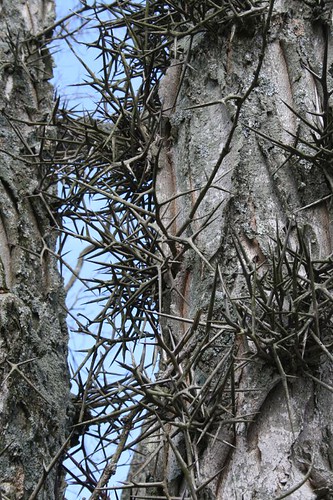
Honey locust, Gleditsia triacanthos, noted for thorns..
(*photo credit)
March 30, 2014 Laetare Sunday and Joy of the Believer
Rejoice, Jerusalem, be glad for her, all you who love her!
Rejoice, rejoice for her, all you who mourned her! (Isaiah 66:10)
How should we conduct ourselves in Lent, especially since we recall on Ash Wednesday to hide any appearance of fasting? As believers, we are expected to have persistent joy and not the supposed gloom of a perpetual Lent. Furthermore, we can ask even whether that gloom is proper in Lent itself and regard the readings of the Liturgy today as proof that this is worth further reflection. Is a penitential season to bring doom and gloom or salvation through joyful practical exercises? Like the blind man who Jesus cures, we have the joy of seeing and following the light of Christ. We are part of the redemption that is occurring at this time and our sorrow should be temporary, for underneath it all the swelling joy of believing cannot be suppressed. A firmness and trust in God gives joy that is worthy of public expression.
We do penance knowing that we are not perfect and in need of reconciliation with God. We want to frankly admit that we can improve and change for the better. This possibility of transformation is itself a source of joy, a matter of continual rejoicing even when the sun is hidden and dark clouds lead to an overcast sky. We are people committed to change, and Lent involves practices that prove that we are people of the word and committed to the Word. Our penance is not because we are doomed and need it, but that we are in the process of being saved and show enthusiasm for the changes we are willing to undertake. We want to be more perfect and in doing so discover that joy increases all the more.
Today's gospel reading speaks of four types of people: the parents who did not have the courage to get involved for fear of what could happen; bystanders who show a sense of indifference to Jesus' presence; Pharisees who do not and would not believe, and the blind man who in being healed becomes a believer. The struggles of all must be understood and yet joy only comes to one of the groups, namely the believer who is being thrown out of the established protection of a religion by being ejected from the community. The joy of finding Jesus is sufficient for him and ought to be for each of us who knows that in our hearts what occurs externally is not sufficient to break our trust in the Lord. And this is true joy! Let's consider this during the week.
Pope Francis insists in Evangelii Gaudium that joy is at the heart of our spreading the Good News to the world, and we are the ones who discover that our mission is one of rejoicing, even when certain times and seasons are trying. Lent prepares us for the added joy of a budding spring that is now before us. We look to a season of new light, renewed foliage, opportunities for outdoor work, and gladness that Christ's resurrection anticipates our own.
Prayer: Father of peace, we are joyful in your word, your son
Jesus Christ, who reconciles us to you.

Seeds to be scattered across prairie landscape.
(*photo credit)
March 31, 2014 Seed Saving as a Conservation Measure
At this time when we are sowing seeds and preparing the spring garden, let us recall that seeds are precious and though small, contain the cultural treasures of previous generations of produce. Those who make an effort to save seeds of varieties that were productive or tasty favorites of the past are to be commended for their efforts. Quite a number of others are doing the very same thing. In fact, they not only preserve variety but they are ensuring that our world does not become vulnerable to reduced numbers of crop variety when new challenges arise, such as global warming. Today, the concentration to a small number of commercial varieties threatens needed biodiversity, especially in an age of rapid climate change and possible extreme weather conditions.
The Seed Savers Exchange was started in 1975 by Kent and Diane Whealy, after Diane's grandfather entrusted them with garden seeds that his parents had brought from Bavaria. The Whealy's began searching for other gardeners who were keeping heirloom varieties and soon discovered a vast, little-known genetic treasure scattered throughout the land. The project grew to thousands of members who collect, preserve, and distribute thousands of heirloom vegetables and fruits. Each year these members offer twice as many varieties as are available from the entire mail-order garden seed industry in North America. Perhaps over a million samples of heirloom seeds have been distributed, many of which are on the verge of extinction. This is the largest non-governmental seed bank.
The headquarters of the Seed Savers Exchange is six miles north of Decorah, Iowa. This 860-acre farm is a living museum of historic vegetables, flowers, herbs, cattle, and fruits. Thousands of heirloom varieties are grown each summer in certified organic gardens to keep the seed collection viable. More than 24,000 rare vegetables, including 4,000 traditional varieties from Eastern Europe and Russia, are being permanently maintained in the gardens at Heritage Farm. The Seed Savers Exchange Yearbook contains 12,495 unique varieties and 19,888 total listings to members from members making this one of the greatest sources of heirloom varieties in the world.
The buildings on the farm are also a treasure. The Amish have built a meeting center in the barn's cathedral-like loft. Also greenhouses, seed storage, a root cellar, and offices are on the grounds. The conference center showcases a classic Amish oak post-and-beam frame and the Visitor's Center next to the gardens is for educational displays and a unique gift shop, offering a wide selection of heirloom seeds and plants as well as other related gardening materials. To receive literature on membership contact:
Seed Saver Exchange, 3070 North Winn Road, Decorah, Iowa 52101.
Phone: (563) 382-5990; website: <www.seedsavers.org>.
Prayer: Lord, inspire gardeners to prize the choice varieties that inspire and enchant growers; give us the forethought to save seeds and exchange these among like-minded individuals and groups.
|